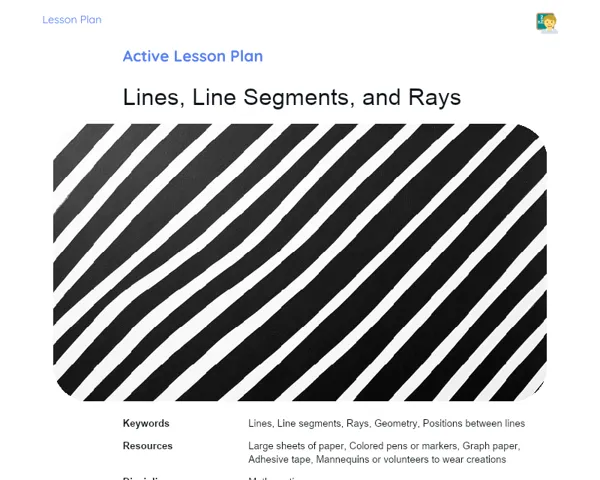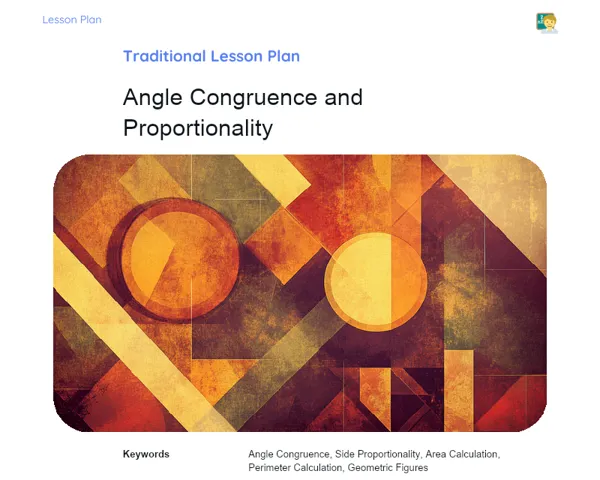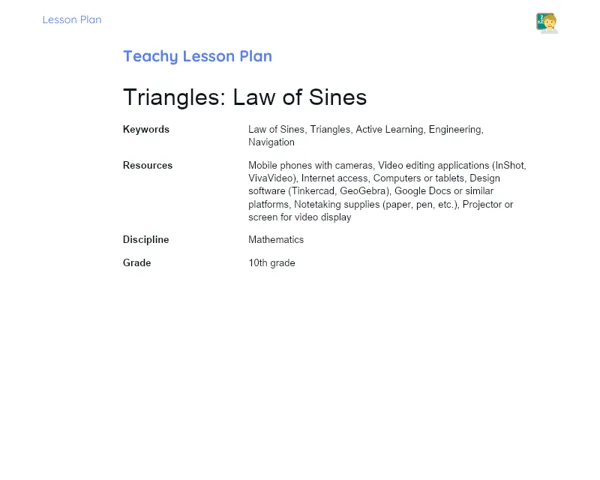Lesson Plan | Lesson Plan Iteratif Teachy | LCM
| Keywords | Least Common Multiple, LCM, Mathematics, 7th grade, Digital Methodology, Practical Activities, Everyday Problems, Digital Tools, Simulations, Group Collaboration, Engagement, Gamification, Mock Social Networks, Technology in Education |
| Resources | Phones or tablets, Race simulation app (e.g., Strava), Online LCM calculation tools, Digital presentation platforms (e.g., Google Slides, PowerPoint), Mock social network platforms (e.g., Padlet, Google Classroom), Educational gamification platforms (e.g., Kahoot!, Quizizz), Collaborative platforms (e.g., Google Docs, Padlet), High-speed internet, Multimedia projector, Computers or laptops for groups |
| Codes | - |
| Grade | 7th grade |
| Discipline | Mathematics |
Goal
Duration: 10 - 15 minutes
The aim of this stage of the lesson plan is to introduce and clarify the primary and secondary objectives, giving a clear idea of what is expected from students throughout the lesson. This includes both the technical mastery of LCM calculations and understanding how this knowledge can be applied to everyday scenarios.
Goal Utama:
1. Equip students with the skills to calculate the least common multiple (LCM) of two or more numbers.
2. Develop the ability to solve real-life problems involving LCM calculations, such as finding equivalent fractions and determining meeting points on a track.
Goal Sekunder:
- Encourage the use of digital tools and online resources to assist with LCM calculations.
- Promote teamwork and knowledge sharing among students through group activities.
Introduction
Duration: 10 - 15 minutes
The purpose of this part is to frame the theme of the lesson and actively engage students right from the outset. By encouraging students to leverage technology for information gathering, we nurture autonomy and curiosity. The key questions help refresh and solidify prior knowledge, setting the tone for the hands-on activities to come.
Warming Up
💡 To kick off the lesson, the teacher should briefly introduce the topic Least Common Multiple (LCM), elucidating that the LCM is the smallest number that serves as a common multiple of two or more numbers. Use relatable examples, like how different events align when they happen at varied intervals. Following this, ask students to quickly look up an interesting fact about LCM on their phones and share it with the class. Encourage a lively discussion about the facts they've discovered, tying them back to the theme of the lesson.
Initial Thoughts
1. 📊 What is LCM and what practical uses does it have?
2. 🔢 What distinguishes multiples from divisors?
3. 🧐 How can LCM be relevant in daily life?
4. 📱 Did anyone stumble upon an intriguing fact about LCM during your phone search?
5. 📚 Has anyone ever needed to calculate LCM in other contexts, like in solving fraction problems? How did that go?
Development
Duration: 70 - 75 minutes
The goal of this stage is to give students the chance to apply the LCM concept in practical, everyday contexts, while utilizing digital technologies to solve issues, share insights, and collaborate with peers. Through enjoyable and interactive activities, we enhance engagement and motivation, enriching learning in a dynamic and meaningful way.
Activity Suggestions
Activity Recommendations
Activity 1 - 🏃♂️ LCM Marathon
> Duration: 60 - 70 minutes
- Goal: Apply the concept of LCM in a real-world scenario and utilize digital tools for simulation and presentation of findings.
- Deskripsi Activity: Students will be divided into groups to determine when two runners, going at different speeds, will cross paths again on the track. By using race simulation apps and online tools, they will find the least common multiple of the runners' speeds to identify the next meeting point.
- Instructions:
-
Divide the students into groups of up to 5 members.
-
Utilize a race simulation app (like Strava or a similar platform) and set two races with differing speeds.
-
Each group needs to calculate the LCM of the runners' speeds to figure out when they will meet again.
-
Students should check their results using online tools (like LCM calculators).
-
After calculating, groups should put together a digital presentation (using Google Slides or PowerPoint) detailing their process and findings.
-
Each group will share their conclusions with the class, discussing any challenges they faced and the strategies they employed.
Activity 2 - 🍕 LCM Pizza Party
> Duration: 60 - 70 minutes
- Goal: Use LCM to address a relatable issue and foster interaction and collaboration through digital tools and mock social media.
- Deskripsi Activity: Students will plan a 'pizza party' where various pizza flavors arrive at different times. They must calculate the LCM to ascertain when all flavors will be available simultaneously. The results will be discussed on a hypothetical social media platform created for the class.
- Instructions:
-
Split the students into groups of up to 5 members.
-
Explain that each pizza flavor is delivered at different intervals (for example, margherita every 20 minutes, pepperoni every 30 minutes, etc.).
-
Groups must calculate the LCM of the delivery times to find out when all flavors will be ready at once.
-
Students should create posts and stories on a mock social media platform (using tools like Padlet or Google Classroom) to report their findings.
-
Groups should engage with each other's posts, comparing results and discussing their different methods.
-
Wrap up with a class discussion on how LCM facilitated problem-solving and the significance of teamwork.
Activity 3 - 🎮 Gamer LCM Challenge
> Duration: 60 - 70 minutes
- Goal: Make learning about LCM interactive and enjoyable through gamification, promoting collaborative problem-solving and the use of digital tools.
- Deskripsi Activity: Students will take part in an online game in teams where they must tackle problems involving LCM calculations to progress through levels. Each level will present a unique contextualized challenge, with students using digital platforms to solve them and document their solutions.
- Instructions:
-
Divide the students into groups of up to 5 members.
-
Select an educational gamification platform (like Kahoot! or Quizizz) to create a multi-level game, where each level features a problem involving LCM.
-
Groups must resolve the problems at each level to move forward in the game.
-
Encourage the use of online tools (like LCM calculators) as aids in problem-solving.
-
Each group is responsible for documenting their solutions and reasoning on a collaborative platform (like Google Docs or Padlet).
-
Conclude the game by having groups share their solutions and methods with the class, discussing the hurdles they faced and how they overcame them.
Feedback
Duration: 20 - 25 minutes
This stage is designed to allow students to reflect and share their thoughts, reinforcing the knowledge they've gained during the lesson. Through group discussions, reflection questions, and 360° feedback, students will have an opportunity to internalize their learning, identify strengths and areas for growth, and acknowledge the significance of teamwork and digital tools in the educational process.
Group Discussion
🗣️ Group Discussion: Run a group discussion with all students where each group shares what they learned from the activities and their outcomes. Use the following script to steer the discussion:
- Ask students about the main challenges they faced during the LCM calculations in the activities.
- Encourage each group to share the primary strategy they employed to address the problems.
- Ask students to discuss how digital tools either aided or complicated the calculation process.
- Invite students to explore how the LCM concept could be applied to other real-world scenarios, beyond those simulated in the activities.
Reflections
1. 🤔 What did you find most engaging about using apps and digital platforms to calculate LCM? 2. 📝 In what ways do you believe group collaboration assisted in tackling the problems posed? 3. 📈 Can you think of any other instances where you could apply the concept of LCM in real life?
Feedback 360º
🔄 360° Feedback: Guide students through a 360° feedback process where each peer must offer feedback to their group members from the activity. Help the class focus on providing constructive and respectful feedback with the following script:
- Each student should highlight a positive contribution from each peer (e.g., 'You did a fabulous job at...').
- Each student should suggest an area where each peer could improve (e.g., 'Perhaps you might consider enhancing...').
- Wrap up the session by having each student express gratitude to their peers for their effort and collaboration throughout the activity.
Conclusion
Duration: 10 - 15 minutes
🎯 Purpose of the Conclusion 🎯
This stage's objective is to reiterate the key concepts discussed during the lesson, reinforcing the significance of LCM and its practical applications. It's also a chance to connect the learning with the students' realities and the modern world, emphasizing the relevance of the acquired knowledge. Lastly, the conclusion provides an opportunity to reflect on the applications of LCM in everyday life, consolidating the learning experience in a clear and enjoyable manner.
Summary
📚 Fun Summary of LCM! 📚
Imagine you're orchestrating a marathon and need to know when two runners, each at distinct speeds, will meet on the track. Or consider planning a pizza party and wondering when all your favorite flavors will arrive together! Now think about leveraging simulation apps, mock social networks, and online games to tackle these issues. That's the real-world application of the Least Common Multiple (LCM)! We compute LCM to pinpoint the precise moments when events align. How's that for an engaging math session filled with technology and enjoyment?
World
🌐 Connection to Today's World 🌐
Through this lesson, the integration of digital tools and focus on practical problems illustrated how mathematics can be employed in genuinely meaningful ways within contemporary contexts. From organizing schedules to solving gaming challenges, LCM is a part of many everyday scenarios, and this lesson showcased how technology can streamline this process, making learning more applicable and relevant to our lives.
Applications
🔄 Applications in Daily Life 🔄
Understanding LCM is crucial for solving issues related to fractions, scheduling, and event coordination. Whether ensuring that various pizza deliveries coincide or calculating when events recur on a track, LCM serves as a practical tool to organize and optimize daily tasks efficiently and effectively.



